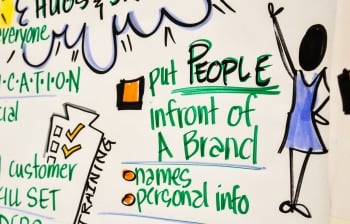
HNI Wisconsin President

Living your brand happens at a personal level. A weak or non-existent corporate brand poses a huge risk because employees do not feel part of a mission. Fear — fear that sales will decline or that customers will leave — becomes the motivation of your people. The mission in a fear-driven organization is to do whatever you can to keep that fear at bay.
More than likely, this mind-set rejects creative problem solving and embracing risk as a profit center. The M.O. is to keep doing what you’ve always done. But we know where that leads an organization: more of the same. Be aware that your competitors have “more of the same” all figured out. Fear of changing the game is what sinks organizations with a weak brand. Brand drives corporate culture, and the importance of corporate culture cannot be understated.
The Benefits of Living Your Brand
Remember that your brand is not what you say it is — it’s what they say it is. Your brand is a moving target. Manage it or ignore it at your own peril. If living your brand is embraced, and your firm projects your brand outward — with clients, prospects, centers of influence, and future team members — what you say your brand is and what they say your brand is should come into alignment.
It’s so important, it bears repeating: your brand is not what you say it is — it’s what they say it is. Think about how a bad product delivered by a bad actor would affect your brand. Recall a time you had poor customer service. A recent visit to an auto service shop drove home this concept for me. The employee at the counter was rude and unprofessional. The brand of the auto service shop now is rude and unprofessional because one customer had a bad experience; their brand now is what I say it is, and I’ll share my experience with friends and family.
Why Complainers Need Extra Attention
In your organization, the people who interface with complainers are your brand vanguards. They are most challenged to live the brand because their audience can change the perception of your brand with one comment on social media, a text to a spouse, or an offhand comment to a co-worker who is looking for a new auto service shop. Because of this, employee risk management is most important for customer service specialists.
A strong brand breeds pride in the workforce as people feel tied to the greater good. They use your brand as a touchstone for handling difficult situations. They stop making decisions based on fear of changing the game because living your brand is empowering. Living your brand also mitigates the threat of people risk.
Constructive creativity comes from having a framework for your people’s efforts. Your brand is that framework — a set of rules that’s your rallying cry. Leverage that rallying cry for consistent and powerful results.

Related Posts:
The Importance of Corporate Culture: A Tale of Two Companies
Employee Risk Management: What It Is and Why It Matters
[WHITE PAPER] Managing People Risk: The Human Side of the Equation
Mighty Mouse: 5 Lessons from Disney World That Can Improve Any Business